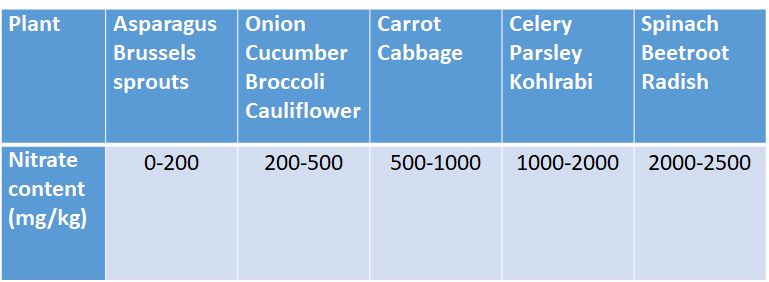Chris Kresser, a man well known to the followers of Paleolithic diets, and a concomitant article by a Hungarian writer in 2012 defended the use of nitrates and nitrites in foodstuffs, primarily in meat products. He presented nitrates and nitrites as substances being present in the human organism anyway, and as metabolic agents, which enter our body only marginally with food. Kresser holds that nitrate and nitrite are present in human saliva in great concentrations, much greater than what we swallow with nutrition. The article also suggests that since there is no evidence as to their mal-effects, we should not be scared of the nitrate and nitrite contained in meats and should not hesitate to eat bacon, which is full of them.
Source: https://www.flickr.com/photos/georgeplakides/26662831402
Taking a closer look at the subject, we find some seriously mistaken conclusions in Kresser’s writing, which, however, the Reader might as well regard as logical. Well, then what is the truth about nitrates and nitrites? Is it justified to use them in the food processing industry; and from where do they get into our body? I promise to submit to careful scrutiny an exciting topic here, and that we shall see it more clearly after reading it.
To begin with, however, you are well advised not to buy meat products that contain nitrate and nitrite, to look closely at the type of water you drink, the vegetables you eat; and women to check the hair dye they use and their kitchen gadgets containing gum. I would also like to shed some light on how consumption of milk and sugar relates to nitrosamines, which belong to the group of carcinogenic compounds. Well, of course, as everything relates to everything else, nitrates and nitrites play a pathogenic role in the cycle and the risks associated with their consumption are not negligible.
This review may seem quite lengthy but still, it is worth reading it. In Hungary, the food control authorities allow the use of 112 kinds of nutrition and food additives. In bio-based products, the following 13 (!) additives are legal: nitrate, nitrite, lactic acid, sodium lactate, sodium ascorbate, sodium citrate, locust bean gum, agar-agar, guar gum, gum Arabic, and xanthan gum. Soybean and milk products (3) are also considered legal additives in meat preparations in Hungary.
Food additives are defined as follows (4): “Food additive is any substance not normally consumed as a food in itself and not normally used as a characteristic ingredient of food, whether or not it has nutritive value, the intentional addition of which to food for a technological purpose in the manufacture, processing, preparation, treatment, packaging, transport or storage of such food results, or may be reasonably expected to result, in it or its by-products becoming directly or indirectly a component of such foods.”
In our understanding of the risks associated with nitrates and nitrites, a 200-year-old technology mostly applied in meat processing should be the starting point. Additives has, for a time, been labelled by E numbers, e.g. by E 249, E 250, and E 252 in the case of the nitrates and nitrites most often employed in the food processing industry. These substances are added to basic food materials to bring about changes in the sensory and nutritional characteristics of meat products. The aim is (at least, allegedly) to prevent certain pathogens from entering the body, add pleasant and lasting colour to the products, and extend their shelf life.
The biologist E. R. Polenski in 1891 demonstrated that bacteria transform nitrate into nitrite. Then in 1899, K. B. Lehmann proved that the pink colour of cured meat was due to nitrite and not nitrate. A chemist, J. S. Haldane in 1901 found following further research that this colour resulted from the combination of the nitrogen-monoxide compound with the meat pigments. Scientists recognized the toxicological effect of nitrate as early as over 100 years ago, and the United States Department of Agriculture from 1908 until 1925 set lower limits for the use of nitrite to prevent nitrite poisoning. In Hungary, extensive use of nitrite in the food processing industry began in the 1960s in spite of the fact that any exhaustive study of nitrites and nitrosamines did not start before the 1970s all over the world. At present nitrate and nitrite are legal food additives and preservatives, though their concentration must be below the maximum limit set in the relevant regulation.
Nitrate and nitrite are chiefly used to prevent disease caused by Clostridium botulinum and other pathogenic bacteria; this is the prime reference today for the utilization of the two substances. Dissemination of bacteria in meat products leads to the enhanced development of toxins. Even small doses (e.g. 0.0024 mg in case of a 80 kg person) of these toxins may cause death because of paralysis of the respiratory organs. Nitrite can control the spread of bacteria, but it cannot influence the effect of the toxin they produce. Well, I have looked at the data made available by the Hungarian Central Statistical Office (KSH). These data show that out of the 846 cases of food poisoning registered in 2009 in Hungary 15% was associated with meat products, and only about every third was linked to Clostridium botulinum (5). To be sure, none of the cases was lethal, which is obviously owed to progress in the field of medical technology, among them of mechanical ventilation. At the same time, in 1889 when nitrates and nitrites were not in use yet, only three such cases were registered in the country (the exact figure cannot be determined due to the annexation of Hungarian territories following the end of World War I).
These figures can be interpreted in several ways, of course, but the difference in the scope and incidence of the disease is quite telling, and the reason for the low incidence is not that the symptoms caused by the bacterium were not known at the time. The most exciting fact in this context is that most cases of meat poisoning in 2009 could not be linked to Clostridium botulinum, while some of the infections the bacterium caused derived from cheese.
The reason why we can establish that the use of nitrates and nitrites is inappropriate to prevent infections is a much more interesting fact. When researchers examined the development, dissemination, and pathogenicity of the bacteria under various conditions, they found that samples from sausages not prepared with nitrite were able to cause illness in mice, and if nitrite was used, that was not the case. However, if they prepared vaccine from the sausage samples and injected it to mice after three weeks, the mice did not become infected, no matter if the sausage contained nitrite or not. There is a simple explanation. Initially (i. e. in the first three weeks) the bacteria (not just those that can cause botulism but other pathogenic bacteria, too) found an excellent medium for propagation, and as the moisture content decreases with the passage of time, the pathogens simply did not find any utilizable matter. As a result, a so-called auto-sterilization of the meat product occurs after three weeks (6).
We also know that the same process does not take place if we keep some meat product like, for instance, sausage, in the refrigerator. That is why sausages and salamis must not be stored in the refrigerator during a three-week ripening period. This was only natural for our grandfathers, but we have to learn it. To be sure, our sausage does not need nitrite to be preserved if we ripen it for at least three weeks, that is, store it at a cool (about 20 degrees C) and dry place. Sausage stored and ripened this way will not cause symptoms of bacterial poisoning because the stomach acid of a value of 1pH immediately eliminates the spores and toxins that may be left behind. No authority would deny that sausage, salami, or ham prepared in this manner preserve their quality for an indefinite period.
Nevertheless, meat products stored for a long time may lose some of their original colour and some of their other quality parameters may seem to deteriorate. However, this relative loss in palatability and appearance does not affect nutritional quality, and hyper- and supermarkets should take care to maintain the attractive characteristics of the products they offer to customers for a long time. At present, this is a more plausible explanation for the use of nitrates and nitrites rather than suggesting that they play a role in disease prevention.
In a medical sense, it would be a serious mistake to use nitrates and nitrites interchangeably. The two compounds have different effects. Nitrates are harmless with an organized biochemical cycle in our metabolism; they are freely excreted in urine and do not generate pathological processes. On the other hand, nitrites, which turn into nitrosamines in the stomach and in other segments of the gastrointestinal tract, are generally regarded as carcinogenic. One of them is dymethilnitrosamine, and there are at least six other compounds whose carcinogenic effects have been demonstrated by experimental studies (on altogether 30 animal species). Of course, similar studies cannot be directly undertaken in the case of human beings. In primates, however, the carcinogenic effect of nitrosamines was unequivocally proven. Whereas no success has been made so far to refute human carcinogenicity, epidemiological assessments have not statistically supported it. However, we cannot assess the results of epidemiological studies without criticism. At the current state of our knowledge, we cannot but accept: yes, nitrosamines very probably have carcinogenic effects and you had better avoid them.
The amount of nitrosamine that evolves from nitrite in the oral cavity and the stomach is, as Kresser established, insignificant and would not cause any problem. Under certain conditions, however, bacteria that are not members of the normal flora enter the oral cavity and the gastrointestinal tract. These microorganisms particularly prefer lactose and glucose. Excessive consumption of milk products and sugar attracts these bacteria, which convert nitrate present in saliva under physiological conditions into nitrite before they are excreted through the kidney, thereby obstructing, or even fatally disrupting, an otherwise normal biochemical process. More nitrates in our body will cause more carcinogenic substances to develop in our organism.
Well, then it is true that nitrate is concentrated in saliva, differently from nitrite concentration, which occurs only in the presence of certain bacteria. That is to say that nitrate, an otherwise harmless compound, is responsible with the help of these bacteria (e.g. Veillonella atypical, Veillonella dispra, Actinomyces dispar, or Rothia mucilaginosa) for the appearance of cancer-causing substances (7).
This is how an innocent nitrate becomes harmful because of Western-type diet, which offers innumerable convenient opportunities to develop dangerous biochemical processes. Indeed, while we are aware that disease prevention and control do not call for the use of nitrates and nitrites at all, we, when we opt for Western-type nutrition, produce carcinogenic substances from the nitrates and nitrites in our gastrointestinal tract.
Now, let us see where nitrates and nitrites come from. A source of excess nitrates in the human body comes from diets rich in vegetables – and cheese. We find them in some vegetables and greens in such high concentrations that they could cause apparent poisoning. Moreover, excessive use of synthetic fertilizers in agriculture, which is inevitable because of soil exhaustion, assists the process. Synthetic fertilizers pollute the waters, too, not only the soil. Thus, water could be an additional source for nitrates and nitrites.
The table below shows the nitrate content of a few vegetables (8). (As vegetables cannot convert nitrates into nitrites, they do not contain nitrites under natural conditions. However, they store the nitrite that comes from fertilized soil.)

Nitrate content of vegetables
For instance, consumption of 15 dekagrams of beetroot may cause acute symptoms of toxicity like blue skin syndrome (methaemoglobinaemia) or a sudden drop in blood pressure. In many cases, food industry advertisers adopt weasel words because they are aware that health conscious customers would not buy products that contain nitrates/nitrites. Food products are usually labelled “no nitrates and nitrites added” whereas bacterium strains injected into food transform the nitrates inherently present in them into nitrites. If someone on paleo diet consumes sugar in the form of fructose, bacterial conversion of nitrates to nitrites in his oral cavity and gastrointestinal tract may lead to the accumulation of surplus nitrites, which in turn increases the concentration of carcinogenic nitrosamines.
It is interesting to note that iron assists nitrites to turn into nitrosamines (needlessly used iron containing food additives and vitamin preparations). Thyocianate, which is present in broccoli, cauliflower, and cabbage in large quantities, has the same effect. That is to say, that consumption of sausages, cured ham, and certain vegetables treated with nitrite/nitrate as well as pharmaceutical iron preparations increase the concentration of nitrosamines. Here again, we arrive at the conclusion that if we allow nitrates and nitrites to enter the kitchen we may definitely potentiate the development of cancer-causing bacteria even alongside a paleo-ketogenic diet.
To avoid that we should buy meat products free of both nitrate and nitrite, and vegetables from farms where we know the date of the last fertilization, and should not eat vegetables and greens stored for a long time. If we prepare smoked meat at home, let us take care that no utensils polluted with dirt are allowed to touch the raw meats and basic materials (the bacterium known as Clostridium may get into the meat with the earth). In addition, when the product is ready we should let it ripen for at least three weeks at a dry cool place and never put it in the refrigerator. If we want to use the fridge, we should not put in the meat earlier than three weeks after the beginning of ripening, and then the temperature should be between 20 and 22 degrees C.
Looking at the world of nitrosamines, nitrites are not the only source for the evolvement of nitrosamines in our system. Sometimes hair dyes, various cosmetic preparations, and gums have high nitrosamine content; beer and other spirits distilled from grain (first of all, whiskey), smoked cheese and cigarettes also contain a sizable amount of nitrosamine. Therefore, we had better keep away from nitrates and nitrites as much as we can, because even it is true that there is a high level of nitrate in saliva, whether it sets off pathological processes or remains innocuous mostly depends on our lifestyle.
References
1. Kresser C. The nitrate and nitrite myth: another reason not to fear bacon. 2013 http://chriskresser.com/the-nitrate-and-nitrite-myth-another-reason-not-to-fear-bacon
2. http://www.tenyek-tevhitek.hu/a-nitrat-es-nitrit-mitosza-semmi-kozuk-a-rakhoz.htm 2013
3. Zsarnóczay G. Biohúskészítményekben felhasználható adalékanyagok. 2010 http://sandbox.georgikon.hu/napok-old/upload/publications/2010-09-02_07-04-49__georgikon-zsarnoczay.doc.
4. 1333/2008/EK rendelet 3. cikke
5. OÉTI adatbázis, http://www.oeti.hu/
6. Leistner I: Hurdle technology. 40-643 p. In: Jensen WK (Ed.): Encyclopedia of Meat Sciences. Oxford: Elsevier Academic Press, 2004. 1472 p
7. Zsarnóczay G. Nitritmennyiségek hatásának vizsgálata húskészítményekben. 2011. http://phd.lib.uni-corvinus.hu/562/
8. Stégerné Máté M, Barta J, Horváth Dné, Ivanics J. Zöldségfélék nitrit-, nitráttartalma és azok feldolgozás alatti változásai. A táplálkozástudomány iskolája. Interdiszciplináris Konferencia a Magyar Tudomány Ünnepe alkalmából. Budapest 2007.

dr. Csaba Tóth
The author is a physician from Hungary with 20 years experience in intensive care medicine, internal medicine and family medicine. He is using the paleolithic ketogenic diet for 6 years in the treatment of chronic conditions including diabetes, autoimmune diseases and cancer.
English translation: Annamária Zsengellér
The Paleomedicina approach is that of evolutionary medicine which has a wholly scientific basis. We do not use naturopathic methods and we distance ourselves from such methods. Our scientific papers published in international medical journals can be viewed here.
2018-02-28
 Rehabilitáció csak online elérhető
Rehabilitáció csak online elérhető
 E-mail: paleomedicina@gmail.com
E-mail: paleomedicina@gmail.com



